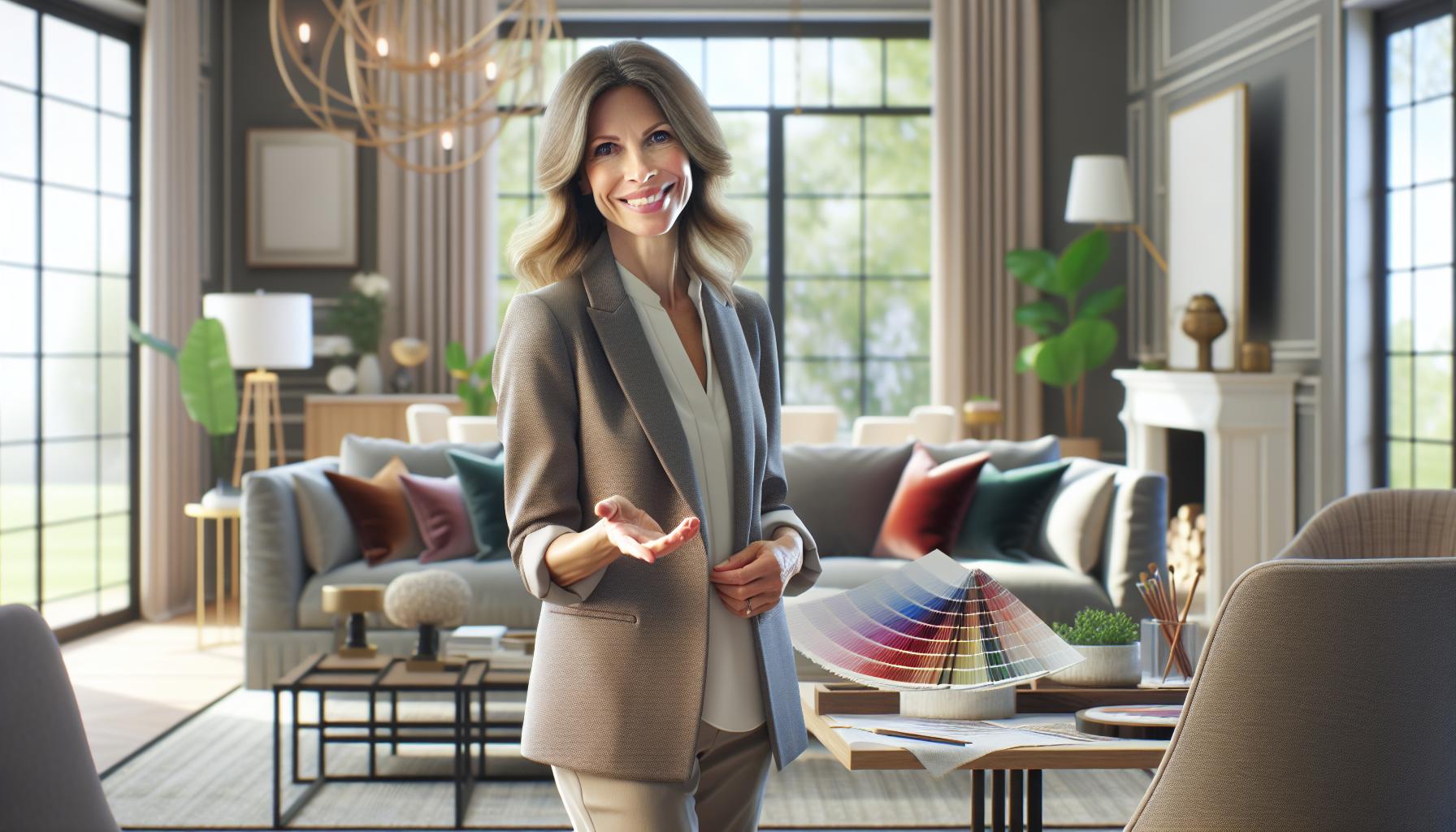Hiring an interior designer can transform a space from ordinary to extraordinary, but many wonder about the costs involved. Understanding how much an interior designer charges is essential for anyone looking to elevate their home or office aesthetics. Factors like project scope, designer experience, and geographical location all play a significant role in determining the final price.
Typically, interior designers offer various pricing structures, including hourly rates, flat fees, or a percentage of the overall project cost. Each approach has its advantages and can fit different budgets. By exploring these options, individuals can make informed decisions that align with their financial plans while achieving the desired design outcome.
Key Takeaways
- Cost Insights: Interior designer fees vary widely based on project scope, designer experience, and geographical location, making it essential to understand these factors before hiring.
- Pricing Structures: Common pricing models include hourly rates, flat fees, a percentage of the project cost, and cost-plus pricing, each catering to different project types and budgets.
- Regional Variations: Costs can differ significantly by region, with urban areas typically demanding higher fees—ranging from $50 to $300 per hour based on specific locales.
- Budgeting Considerations: Setting a realistic budget involves evaluating project goals, gathering multiple quotes, and anticipating additional costs like furniture, renovations, and unexpected fees.
- Value of Professional Design: Hiring an interior designer provides expertise, resource access, customized solutions, and can enhance property value, making it a worthwhile investment beyond initial costs.
How Much Interior Designer Cost
Understanding interior designer costs is essential for anyone considering a project. Various factors influence pricing, from the scope of the project to the designer’s experience.
Factors Influencing Costs
- Project Scope: Larger projects require more time and resources, leading to higher costs.
- Designer Experience: Established designers with extensive portfolios often charge premium rates.
- Location: Urban areas typically have higher living costs, which reflect in design fees.
- Design Complexity: Unique or intricate designs may incur additional fees due to required expertise.
- Timeframe: Urgent projects generally lead to increased costs due to expedited services.
- Hourly Rates: Designers charge a set hourly fee for their services, beneficial for smaller projects or consultations.
- Flat Fees: A predetermined rate for the entire project often suits larger or more detailed endeavors.
- Percentage of Project Cost: This model typically ranges from 10% to 30% of the overall project cost, aligning designer fees with the project’s financial scope.
- Cost-Plus Pricing: Designers charge clients for materials plus a markup, fostering transparency about costs.
- Retainer Fees: Clients pay a retainer for ongoing services, useful for long-term projects or continual consultation.
Understanding these aspects aids clients in determining how much they can allocate toward hiring an interior designer while achieving their design goals.
Average Costs of Interior Designers

Understanding average costs associated with hiring interior designers provides a clearer view of potential expenses. Costs can vary significantly based on multiple factors, including regional differences and the specific services provided.
Regional Variations
Region plays a critical role in determining interior design costs. Urban areas typically feature higher costs due to increased demand and living expenses.
- Northeast: Designers often charge between $100 and $250 per hour in major cities like New York.
- Southeast: Rates can range from $75 to $200 per hour in cities such as Atlanta.
- Midwest: Expect charges between $50 and $150 per hour, with Chicago at the higher end.
- West Coast: Costs range from $100 to $300 per hour, particularly in Los Angeles and San Francisco.
These variations highlight how location impacts budget considerations for design services.
Price Ranges for Different Services
Services offered by interior designers also affect pricing structures.
- Hourly Consultation: Charges typically range from $50 to $300 per hour, depending on the designer’s experience.
- Flat Fees: Many designers provide a flat fee model, which can range from $1,000 to $10,000, based on project complexity.
- Percentage of Project Cost: Designers may charge 10% to 20% of the total project cost, suitable for larger renovations.
- Cost-Plus Pricing: This approach adds a markup (often between 20% and 35%) on furnishings and materials, providing flexibility for various budgets.
- Retainer Fees: Retainers might require an upfront payment of $1,500 to $5,000, securing ongoing designer services.
Understanding these pricing ranges enables individuals to select the services that align with their budget and design objectives.
Budgeting for Interior Design

Budgeting for interior design involves understanding all possible costs associated with hiring a professional. A well-planned budget allows for better allocation of funds and smoother project execution.
How to Set a Realistic Budget
Setting a realistic budget starts with defining design goals and desired outcomes. Evaluating the project scope helps in estimating necessary expenses. It’s important to research average costs in the target area. Gathering several quotes from different designers provides a clearer picture of possible expenses. Clients should also consider the percentage of their home’s value that can be allocated for design services; generally, this falls between 5% and 15%. Prioritizing essential features ensures that the most critical aspects of the project receive adequate funding while keeping overall costs manageable.
Potential Additional Costs
Potential additional costs may arise throughout the design process.
- Furniture and Decor: Along with design fees, clients often incur expenses for furniture and decorative items. These costs vary widely based on quality and brand.
- Construction and Renovation: If remodeling is involved, budget for construction permits, contractor fees, and materials.
- Travel Expenses: For designers working in multiple locations, travel costs may increase the budget.
- Consultation Fees: Initial consultations can also carry fees, ranging from $50 to $300.
- Unexpected Fees: Unearthed issues during the project, such as structural or electrical problems, can lead to additional expenses.
Being aware of these potential costs helps clients prepare financially and avoid surprises during the design journey.
Value of Hiring an Interior Designer

Understanding the value of hiring an interior designer extends beyond mere costs. Engaging a professional offers numerous advantages that often lead to greater long-term satisfaction.
Benefits Beyond Cost
- Expertise in Design: Interior designers trained in aesthetics and functionality elevate spaces using their knowledge of color theory, space planning, and material selection.
- Time Savings: Designers manage logistics and sourcing, allowing clients to focus on their daily responsibilities without sacrificing quality.
- Access to Resources: Interior designers typically have access to exclusive resources, materials, and suppliers, which may not be available to the general public.
- Increased Property Value: A professionally designed space can enhance property appeal, resulting in potential increases in resale value.
- Customized Solutions: Designers create tailored solutions that reflect individual lifestyles and preferences, ensuring spaces meet specific needs.
- Designers Are Only for the Wealthy: Hiring an interior designer is not just for high-end clients. Many designers work with various budgets and can adjust their services accordingly.
- Design Is Just About Aesthetics: While beauty is important, designers focus on function as much as form, ensuring spaces are practical and livable.
- Clients Lose Control Over Their Vision: Designers collaborate with clients to understand their vision, facilitating a partnership that respects the client’s style while providing professional input.
- Interior Design Is Expensive: While some projects may incur high costs, there are options available that offer value, such as hourly rates or flat fees, allowing clients to manage budgets effectively.
- Designers Only Work on Large Projects: Interior designers can assist with small-scale projects, including single-room redesigns or consultations, proving beneficial regardless of project size.
Informed Decisions
Understanding the costs associated with hiring an interior designer is crucial for anyone looking to elevate their space. By recognizing the various pricing structures and factors that influence fees, clients can make informed decisions that align with their budgets. It’s essential to consider not just the financial implications but also the value that a designer brings to a project. With careful planning and clear communication, individuals can achieve their design goals while enjoying a seamless and rewarding experience. Ultimately, investing in professional design can lead to lasting benefits that enhance both aesthetics and functionality in any environment.